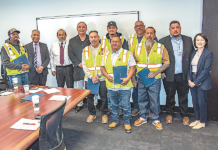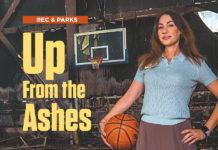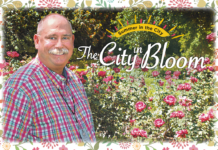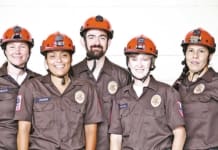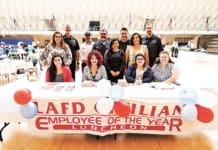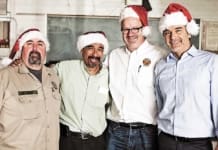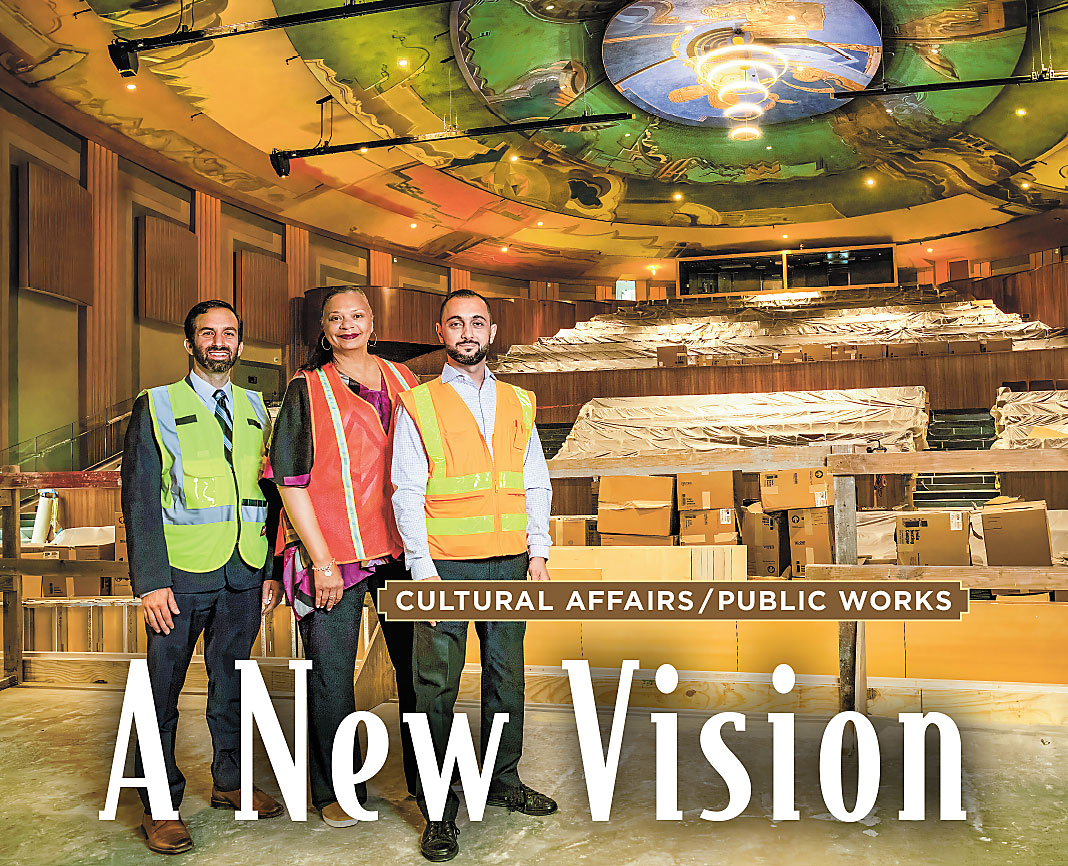
Photos by Summy Lam, Club Chief Operating Officer; Rebecca DeBolt, Club Customer Service Rep; Dearbhla McNulty, Club Social Media Creator; and courtesy Cultural Affairs
Avision of hope, art and life is nearing completion in South LA’s Leimert Park – the impressively restored Vision Theatre Performing Arts Center. It’s a project of Cultural Affairs, Public Works/Engineering, many other City departments, and countless community activists who have long dreamed of reopening it.
After a long and multi-phase restoration, the majestic and impressive Art Deco landmark Vision Theatre Performing Arts Center is set for its grand reopening in 2025.
It’s one of the biggest projects the two lead departments are working on.
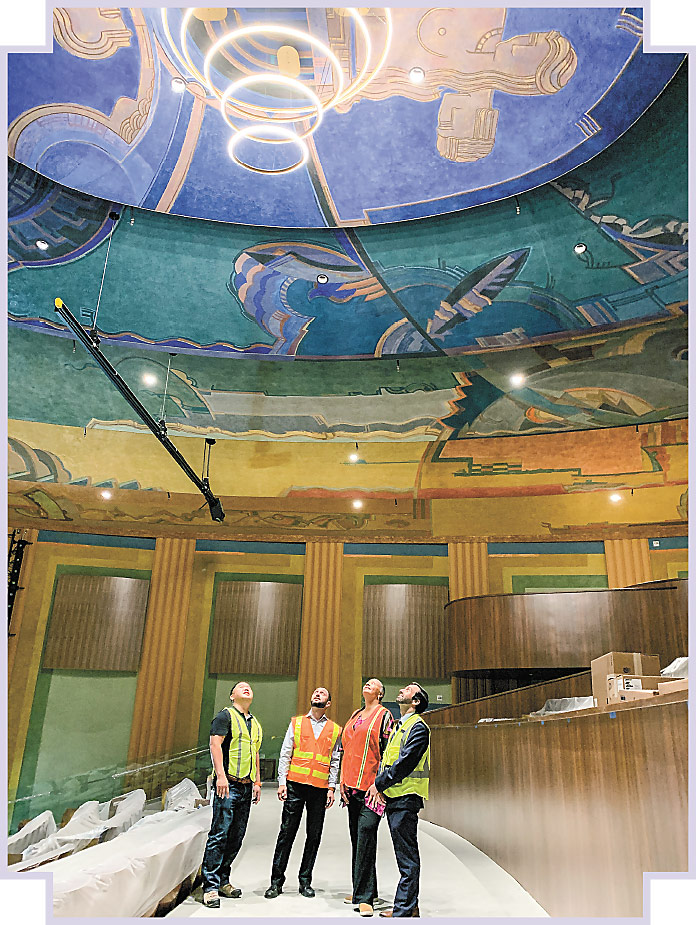
A large neighborhood movie palace, this 1931 Spanish-style art-Deco gem has retained its importance to the community for more than 80 years since it first opened as the Leimert Theatre in 1931. It became a neighborhood movie Theatre soon after opening and was operated by Fox West Coast Theatres. Designed in a classic Southern California streamlined Spanish Colonial style, the tall steel frame on top of the lower stucco-clad tower originally had the Theatre’s name on it, and is a landmark for the area.
The Vision Theatre completed a $11 million renovation in 2011, and final construction on phases II, III and lV began in March 2018 to start historical restoration of the auditorium, reconfigure seating within the existing walls, add a lounge area under the seating, enlarge the stage, add a fly loft with office spaces, and build lower level dressing rooms, green rooms, a trap room, technical staff office space, and an orchestra pit. Phase V is set to begin this fall, leading to opening the curtain for good in 2025. •
![]()
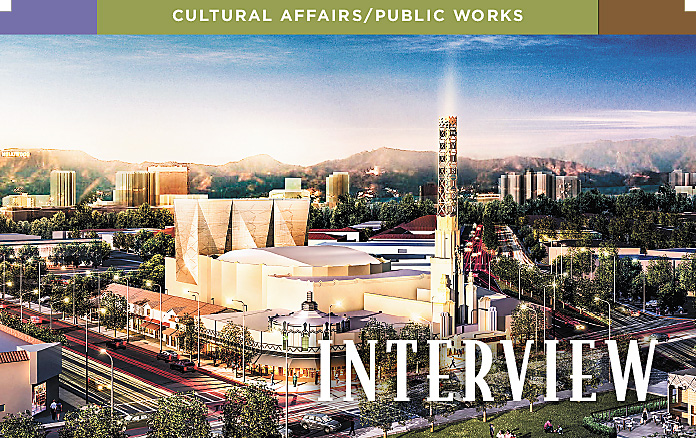
‘A beacon in Leimert Park’
On July 25, Club CEO Robert Larios and Alive! editor John Burnes interviewed four City employees who are managing StreetsLA’s’ sustainability efforts for project status updates to the EV Sweeper test and the overall Center for Green Innovation. The interview subjects were Ana Tabuena-Ruddy, Assistant Director and new Chief Sustainability Officer, StreetsLA, 11 years of City service; Michael Cox, Division Manager, Street Maintenance, 34 years, Club Member; Alex Lozano, Equipment Specialist, StreetsLA, 39 years, Club Member; and Brent Jones, Superintendent of Cleaning, StreetsLA, 26 years. • The interview was conducted via Zoom.
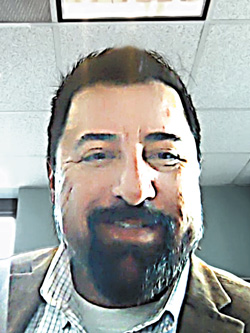
Robert Larios: Asatur, Yvonne and Daniel, thank you for talking to us about this incredible joint project between Cultural Affairs, the Bureau of Engineering, and many other City departments. But before we talk about that, let’s start with this – how did you get to your current position with the City?
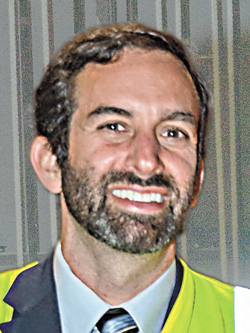
Daniel Tarica: I’m grateful for the many different experiences and opportunities I have had working for the City that prepared me for the work I am doing today with Cultural Affairs. I’ve worked for several different elected officials: serving as a field deputy for a City Councilmember; then serving as a Legislative Director for the President Pro Tem of the City Council; and serving as Deputy Controller for two different Controllers. Additionally, I worked for the City Administrative Officer as a budget analyst as well as in municipal finance, providing the education and training to prepare me for my work at Cultural Affairs, first as Assistant General Manager and now as General Manager.
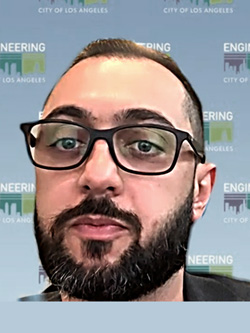
Asatur Keymetlyan: Very simple for me: Right after my undergraduate degree at Woodbury University, I was offered a job with the City. I started with the architectural division 16 years ago. I was an Architectural Associate I, and just basically I grew through the ranks.
Yvonne?
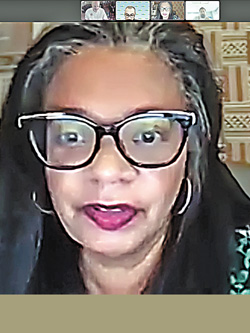
Yvonne Farrow: The seed for public service was first planted when I volunteered as Block Captain for my Neighborhood Watch while pursuing a professional career in the performing arts. Formerly a concert dancer and model, I was an award winning union actress, filmmaker and choralographer – I choreographed for choirs. I was also co-partner in the production company Twinbiz (twins-in-the-business), writing, directing and producing original projects for stage, television and film, with an emphasis on social justice. I was soon vetted and selected as an Organizing Fellow in President Barack Obama’s re-election campaign, and ran the South LA GOTV campaign office. I was then hired as Field Organizer running the South LA office of Eric Garcetti for Mayor (which he dubbed the number-one office of his campaign). From there I joined the Office of Mayor Eric Garcetti, where I served as Constituent Service Representative. I then transferred to Cultural Affairs and became a civil servant in the position of Arts Associate. I was promoted to Arts Manager II, where I now serve as Project Manager overseeing the Vision Theatre from its renovation through its reopening.
What a unique, interesting path.
Yvonne: Yes, I’ve come full circle. It’s been very exciting.
Asatur and Yvonne, have either of you worked on a theater project before?
Asatur: This will be my first theatre project, managing the construction of a theater.
Yvonne: This is my first time being on this side of the stage, not as a director, producer or artist.
![]()

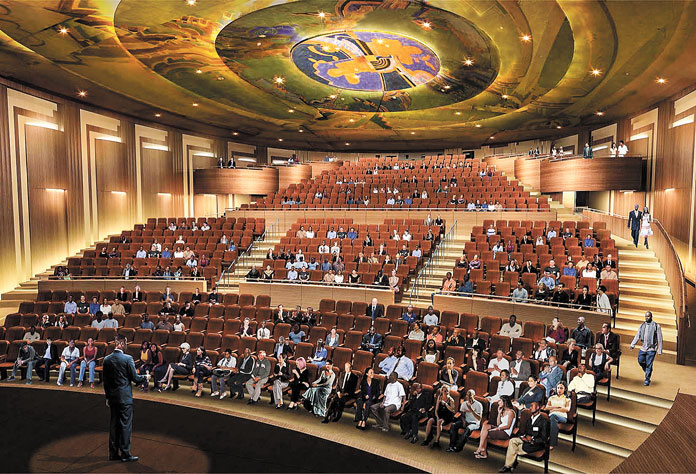
The Vision Theatre
In general terms, please describe the Vision Theatre Project, what it is and the timeline from beginning to the expected completion.
Daniel: DCA’s Vision Theatre, once an Art Deco movie palace sporting a blend of Streamline Moderne and Plateresque styles, was built in 1931. It’s nestled within the heart of Leimert Park as a beacon of inspiration and resilience for the communities it serves. The Leimert Park Cinema, or Leimert Park Theatre, screened movie classics until its doors closed in 1963. In 1977 it became a Jehovah’s Witness Chapel known as the Watchtower.
Yvonne: Then in 1990, actress Marla Gibbs bought the property and renamed it the Vision Theatre and emboldened the name vertically along its majestic spire. However, due to civil unrest and economic recession, Marla’s dream of an 850-seat performing arts Theatre and education facility fell on hard times. In 1997 the City of Los Angeles acquired the property with the goal of transforming the historic Theatre into a state-of-the-art, world-class performing arts center, thereby sustaining and advancing Leimert Park Village as the mecca of Black arts, culture, and entertainment in Los Angeles.
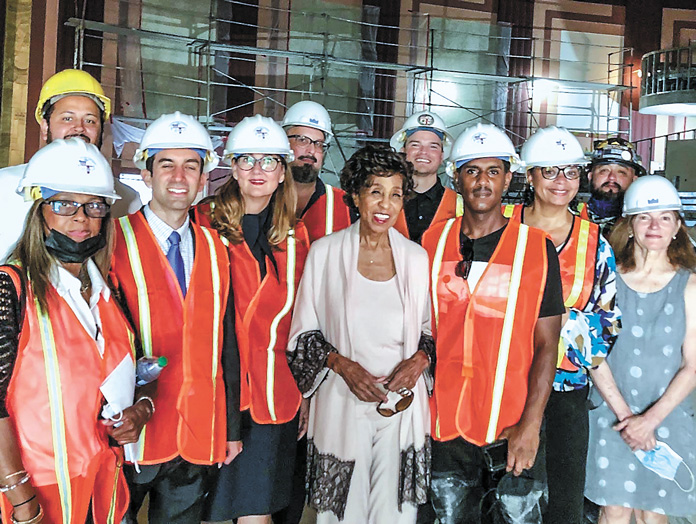
Daniel: Once the renovation project was approved, Cultural Affairs reached out to the Board of Public Works’ Bureau of Engineering to assist in the Theatre’s design, construction and renovation. City partners also include the Bureau of Contract Administration (BCA), overseeing contracting and payments, and General Services.
This is probably a good time to talk about the phases of construction.
Asatur: The project was designed as one complete project, but then due to funding shortfalls, a decision was made to split this into multiple phases.
Yvonne: Phase 1 began in 2011 and was completed in 2013. We renovated and restored the front portico, lobbies, upstairs offices, classroom and restrooms. Once funds were raised to complete the audience chamber, renovations resumed in 2018.
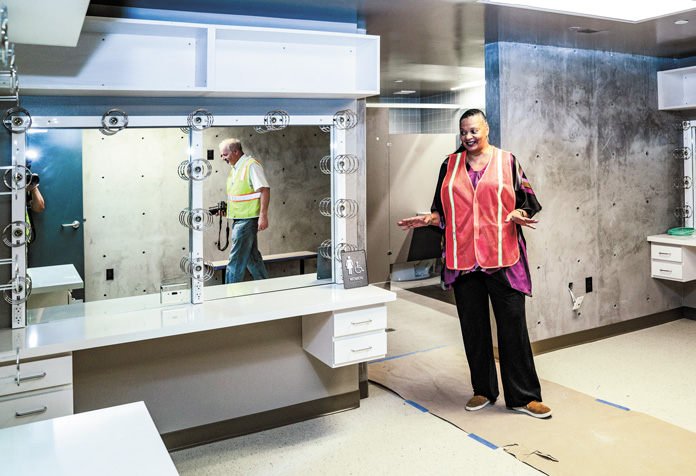
Asatur: The City is in the process of completing Phases 2 through 4. These phases included restoration of the historic ceiling mural; renovation of the audience chamber; construction of a formidable stage with a fly loft, a loading dock, a lounge; event space, production offices, storage space, dressing rooms, a greenroom, and artist and patron amenities; as well as reconstruction of the iconic neon marquee and parking lot sign. We’re nearing the completion of Phase 4. We’re hoping by the end of this summer, we’ll have these phases completed. Now, we have a fifth phase. The future Phase 5 will include miscellaneous items that were not completed in Phase 4. We’re aiming to start that scope at the end of the summer and be completed by July 2024. We can’t open the theater until Phase 5 is finished to ensure that certain infrastructure for the Theatre is operational, such as finishing the parking lot and some other things that were not included in the initial phases.
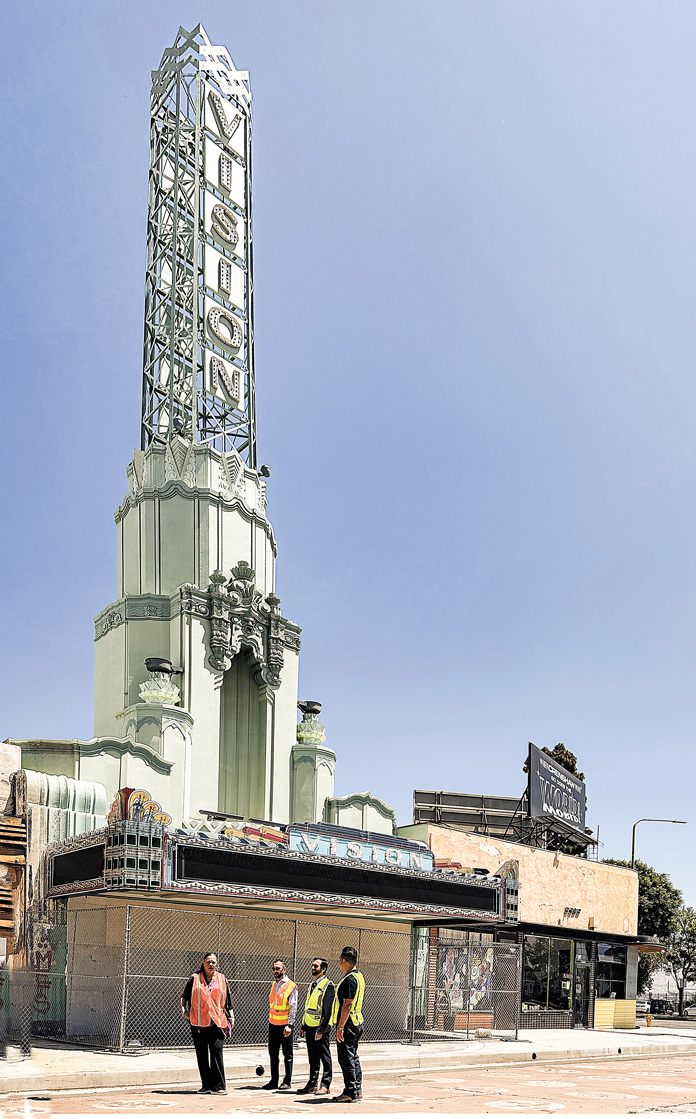
Yvonne: We’d like to have the power lines placed underground so that “bus and truck” tours can turn around safely and then back up to the loading dock and unload, that emergency vehicles can have untethered access, and supply trucks can get through, that kind of thing.
Asatur: We’re in conversation with the Department of Water and Power now. That’s also another major undertaking that requires additional funds, and we’re working on those.
Has the building been registered historically?
Daniel: While the Vision Theatre is not a registered Historic-Cultural Monument, there are elements of the building that have been deemed “historic.” For example, the renovation of the audience chamber included the demolition of a non-historical stage, which now features an ample fly loft, backstage area, trap door, and hydraulic orchestra pit lift which, when raised, extends the apron of the stage.
How much has the City invested so far?
Daniel: To date, the City has invested $37.3 million in infrastructure upgrades, interior improvements, preservation, restoration and renovation of the facility. Once the capital infrastructure is completed, we’ll embark on Phase 5, which will include installation of top-of-the-line audiovisual and lighting equipment, a redesign of the parking lot to accommodate large theatrical and emergency vehicles, the placement of power poles underground (to eliminate blight), as well as other necessary upgrades to the interior.
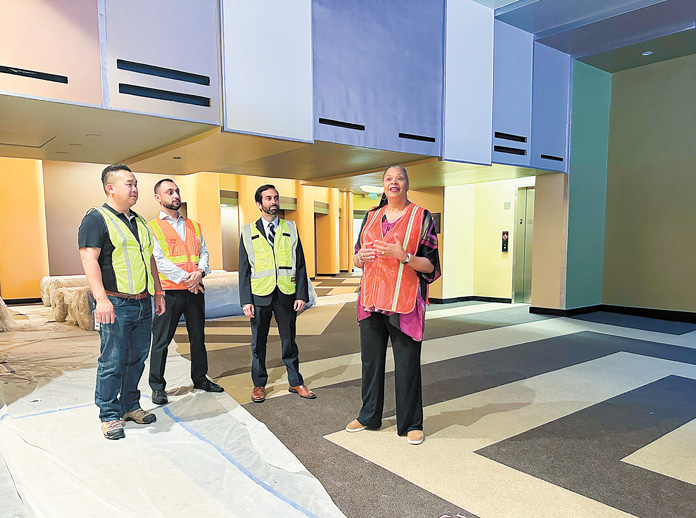
Yvonne: The intended date for completion of the renovation is 2024. We anticipate a grand re-opening celebration with Cultural Affairs’ new partner/operator in the 2025 winter/spring season, also the Vision Theatre’s 94th birthday. Once completed, the Vision Theatre will once again serve as a significant cultural anchor and artistic hub for the local community, Los Angeles at-large, and as a major national and international theatrical destination.
Are you working with theater design consultants?
Asatur: Back in 2004, we enlisted one of our architectural design consultants, FSY Architects, to be the architect of record for the project. They’ve been with us on this journey for a long time. And they have recruited a theatrical consultant and many other consultants to get this project completed.
![]()
 Beyond the Walls
Beyond the Walls
Why did the City buy this Theatre? What does it mean to the Leimert Park area and the citizens of South LA?
Daniel: The City is making this investment in the Vision Theatre for it to be a community resource and symbol of community and Citywide pride. It will grow opportunities for Leimert Park and the larger Los Angeles communities to engage through the programming of diverse world-class Theatre, music, dance, film, and educational events, along with offering a variety of cultural forums.
Yvonne: It means the world. Have you heard the saying, “a rising tide lifts all boats?” When the Vision Theatre reopens, our hope is that it will be an anchor and catalyst for the economic development and revitalization of Leimert Park, the surrounding community, and the City of Los Angeles; that the Theatre will be a home for deep cultural connection; a place of joyful community engagement; that it will serve as a center for community celebration and commemoration; that it will reaffirm and reestablish the theater as the hub of cultural activity for the African-American experience and cultural expressions of the diaspora.
The Vision Theatre will host educational opportunities for youths in performance and stagecraft, providing job training, as well as provide an affordable world-class space for local artists and arts organizations to shine. Similar to the Apollo Theatre in Harlem, South LA will have its own Pantages or Wiltern Theatre, right here in Leimert Park Village. We also hope to hire local vendors in the space. There is a lot of hope for this place.
And not just local productions, but for touring shows, too.
Yvonne: Oh my goodness, yes. This is first and foremost a rental facility. We want to attract small and large national tours, concerts, and conventions.
That will require a facility that can handle the best shows out there.
Asatur: Yes. We’re building to accommodate groups and shows of all sizes . We’ve recently redesigned what the original plans called for in terms of technology. As you can imagine, a design from 2004 to 2007 called for equipment that is now outdated. As we’re nearing completion, Cultural Affairs wanted to make sure that this theater is state-of-the-art and can attract high-level performers. To do that, you need to have the best of the best equipment. We made sure to revise the original design and equipment to bring it up to current standards. We’re working with a design consultant to install one of the number one sound and lighting equipment setups in the industry currently. Our intention is to make this a world class performance center.
Yvonne: I also feel that this will be a tourist destination, that people will want to come through, not just for shows, but also to see it. The Vision Theatre is a living museum, and people will want to come and visit it.
Asatur: The existing audience chamber has been redesigned, reconstructed and restored when it comes to the walls and the ceiling. It’s going to have more than 700 seats. For the first five rows, we were able to restore and reuse the existing original seats from the Theatre. The remaining seats will be replicas of the original seats.
Yvonne: The proscenium arch around the stage is the exact color it was in 1931, a deep magenta with gold folds; it’s gorgeous. The Heisenburge ceiling was restored to its former glory and is just breathtaking. Below it, curves of boxed seats kiss the walls, creating the balcony. FSY designed a new chandelier that was recently featured in the LA Times.

What other departments are working on this project?
Asatur: I’m with the Architectural Division, so I oversee design consultants on managing the project from the construction portion of the project. I have my colleagues from the Construction Management Division working with me managing contractors. We also have Contract Administration involvement because this is a Public Works building project, and it’s gone through a bidding process. We’re also working with Council District 10.
Yvonne: General Services is very involved.
Asatur: Yes, as well as LADOT for a portion of the parking lot.
Yvonne: And LADWP.
Asatur: Of course, for power requirements and inspection. The Housing Dept. is providing much of our funding. It’s important to note that there are a couple of other big projects that are happening adjacent to our project. One of them is the Degnan Street Improvement Project, involving Street Services and a couple of other departments. There is constant coordination with our project.
![]()

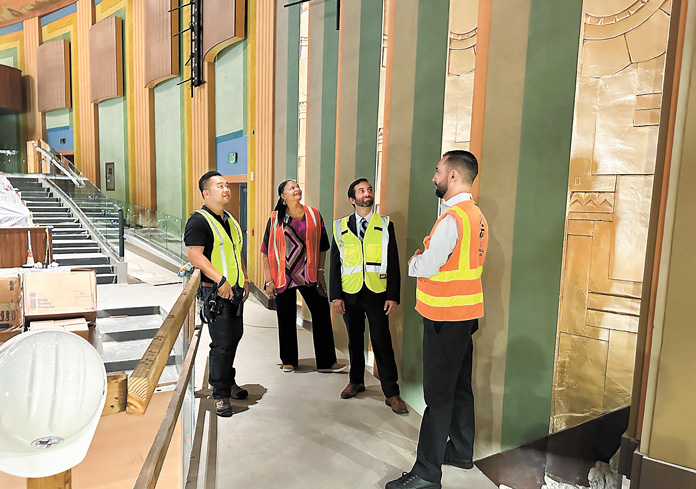
Challenges
There have to be some unique challenges in managing this project.
Daniel: While we continue to make good progress on the construction, we have faced several challenges along the way. They include, first, the long gap in the renovation process, especially the time between the first phase and the second set of phases due to securing funding. Once funding was secured, a global pandemic hit and delayed the project due to a shortage of resources and supplies.
Second, the City’s search for a well-qualified business and nonprofit with proven experience in venue management, festival production, and performing arts producing and curation – with an emphasis on technical stagecraft, concert booking/contracting/presenting, arts/venue management, community engagement/youth development, arts education, and facilities maintenance has been a unique challenge. In our search, Cultural Affairs asked for proposers with proven experience in strong financial management, events marketing, ticketing, artist services, audience services, security, scheduling, parking, technical direction, and customer service. In addition, we asked for proven experience in: the creation of a wide range of public programs that support community and youth performance opportunities; job training and creation; and creative entrepreneurship with an emphasis on the performing arts, stagecraft, and production.
We look forward to moving ahead with a qualified venue partner operator/programmer in the coming months and hosting the grand reopening of the Vision Theatre in 2025.
We’ll look forward to that!
Asatur: We can spend the entire day talking about challenges!

Yvonne: When I first came on board in 2017, the designs were not for a world-class theater. My former supervisor noticed that the plans were more suited for a high school auditorium, not to attract top-notch companies like the Alvin Ailey Dance Theatre, or musicals like The Lion King, or stage plays or even concerts. There was a lot of work to do. As the years went by, plans had to be upgraded, upgraded, and then upgraded again. Cultural Affairs really wants to deliver the best product to the community and to the City that we can.
Asatur: As you start remodeling any type of existing building, you find a lot of surprises. It’s very typical. Imagine trying to phase this project because of funding issues; you have to split it up into four phases. As a project manager, I have a challenge in reporting to a number of funding sources. The Housing Dept. is providing a majority of the funding for the current phase of the project through Community Development Block Grant (CDBG) funds.
The historic nature of the project also adds a layer by having a historic preservation consultant overseeing every element of this project. As we reached the audience chamber, which, in my opinion is the most iconic portion of the interior of the theater, we encountered a lot of delays dealing with the great mural on the ceiling. Restoration work was tedious, but the outcome is very beautiful.
We also have been very engaged with our neighbors, and we work closely with them. At the end of the day, they all appreciate what we’re doing for the community, for Leimert Park, and what value we’re adding to their own properties.
Yvonne: This is where I come in. As Cultural Affairs’ Project Manager, I work closely with our neighbors and my fellow Project Manager, of course; liaise with CD 10, the City Attorney, the contractor, General Services, Community Investment for Families Dept., and Housing’s CDBG. I attend many community meetings making sure they are informed. I also oversee the process working with our new partner/operator from proposal to contract.
There was one other challenge that I wanted to add – COVID. Boy, did that throw a wrench in an already overly extended timeline. It was very, very difficult.
![]()
 The Essence of Cultural Affairs
The Essence of Cultural Affairs
How does this fit into the mission of Cultural Affairs?
Daniel: As a leading, progressive arts and cultural agency, DCA empowers Los Angeles’s vibrant communities by supporting and providing access to quality visual, literary, musical, performing and educational arts programming; managing vital cultural centers; preserving historic sites; creating public art; and funding services provided by arts organizations and individual artists.
Formed in 1925, Cultural Affairs promotes arts and culture as a way to ignite a powerful dialogue, engage LA’s residents and visitors, and ensure LA’s varied cultures are recognized, acknowledged and experienced. DCA’s mission is to strengthen the quality of life in Los Angeles by stimulating and supporting arts and cultural activities, ensuring public access to the arts for residents and visitors alike. This Vision Theatre project is a perfect match.
![]()
 Stories
Stories
Is this the biggest project you’ve worked on?
Yvonne: Regarding bricks and mortar, it’s the biggest and the first for me. I am grateful for the many years of experience I have as a producing artist and the transferable skills I brought with me to the job. My knowledge is extensive because I have been on the stage and I can answer the questions raised. I can speak for the artists who will perform there. I know what producers will want from programmers. I know what directors will ask of technical directors. I am in a unique position also because I know how the City works from having served in the Mayor’s Office as a Constituent Service Representative. I give thanks every day for my background, life experience, and the institutional knowledge gained working in the trenches of City government.
Asatur: I oversee a group of project managers and designers on something like 40 projects. But this is the one project that I’ve kept for myself. I’ve stayed on it as the lead project manager because I want to see it through. This is the most challenging and my biggest project currently. I’m sure it’s going to be the most rewarding once it’s completed. I don’t want to hand it over to anybody else. I love working with Cultural Affairs. Yvonne is one of my most favorite people, so I don’t want to let her down.
Yvonne: Likewise, I’ve learned so much from you, Asatur.
Tell us a couple of stories from doing this project.
Yvonne: Okay, great! I have a few!
To begin construction on the auditorium we had to demolish the back wall of the stage. Facing the parking lot was a mural that featured Marla Gibbs (the first African American to invest her wealth in this community), drummer Billy Higgins, poet Kamau Daaood, composer/pianist Horace Tapscott, and other celebrities of the day. Before tearing down the wall we honored the muralist, Michael Massenburg; Marla; the stakeholders and family members of those depicted in the mural. It was very touching.
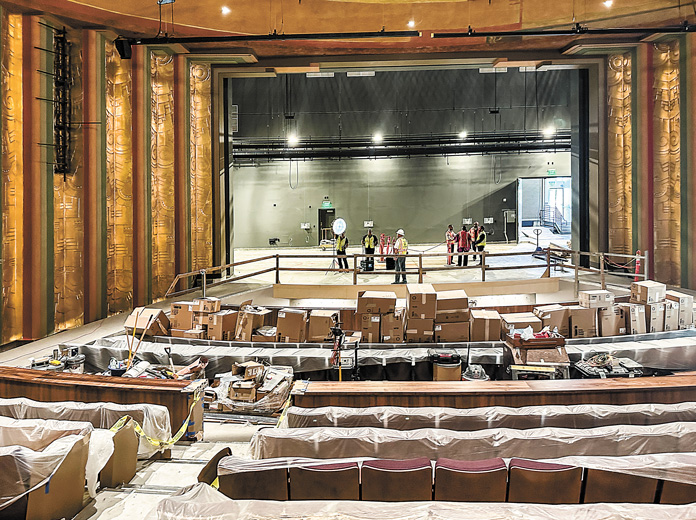
Another great moment at the onset was the beam signing. All of the City partners came out to sign this massive steel beam and watch it being raised and placed high on top of the building, it was just so exciting. My name is on that building!
During construction I heard the contractor talking about putting in a dance floor. I thought, isn’t it a little too soon for that, it’s going to get ruined. I asked, “Why are you putting in the dance floor now? Isn’t that a waste of money?” Everyone laughed! “No, Yvonne! It’s not a real dance floor! We’re going to build scaffolding to restore the ceiling. The dance floor is what the artisans will work on while restoring the ceiling!” I have two bad knees from my career as a dancer, plus arthritis, but I pulled myself up there just to touch that ceiling! I have a picture to prove it!
At one point we gave away memorabilia from the Vision Theatre as keepsakes such as air vents that could be melted down for art pieces, theater seats for houses needing seating, or seats that could be used as set pieces, for example. One woman asked if she could have an armrest. It reminded her of the many dates she went on at the cinema as a teenager. We gave away a lot of armrests! So many of the community members shared their stories. It was incredible.
We also had a competition to select a design for the Vision Theatre Legacy Curtain – local artists came up with beautiful designs, and the community voted. The design they chose is of stunning African masks called “Sankofa,” which loosely means “to go back and get it” or “to remember our history, to reclaim it.” The Legacy Curtain will debut at the grand re-opening.
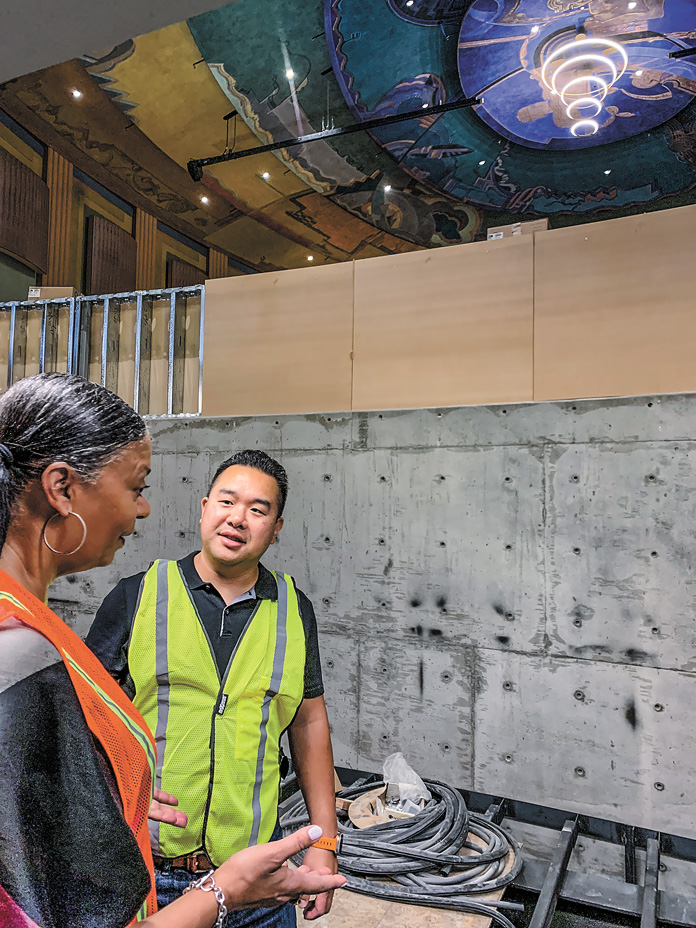
Asatur: That Sankofa passage is one of my favorites. The theme that Yvonne was referring to for the legacy curtain is also incorporated throughout the fencing of the Vision Theatre parking lot. It was new to me that I had to learn. I wasn’t familiar with the different cultures, so that was very exciting and interesting to me.
Marla Gibbs also visited the site on another occasion, which was very exciting, but the dance floor is probably one of my favorites. Seeing that scaffolding go up with its magnitude…and actually climbing up and touching the ceiling and seeing the detailed work that the artists have done on the ceiling and the restoration process with its gold accents, it was incredible. The ceiling is about 40 feet high from the ground. You can’t understand the magnitude of it until you get close to it. I don’t think anybody else will ever get the opportunity to get up close to the ceiling as we did, Yvonne, and see the detailed plaster work done originally in the 1920s.
We had a little bit of a challenge with the chandelier that’s supposed to hang from the center of the ceiling. It’s an important piece of the theater, but we were worried how it would impact the artwork, the mural, and the great work by our design consultants. They came up with a very elegant design for the chandelier, which is very beautifully done, and it’s incorporated very tastefully within the space so it does not take away from the mural directly above it. That’s got to be one of my most favorite parts of the project.
Yvonne: It’s futuristic and it’s gorgeous.
![]()

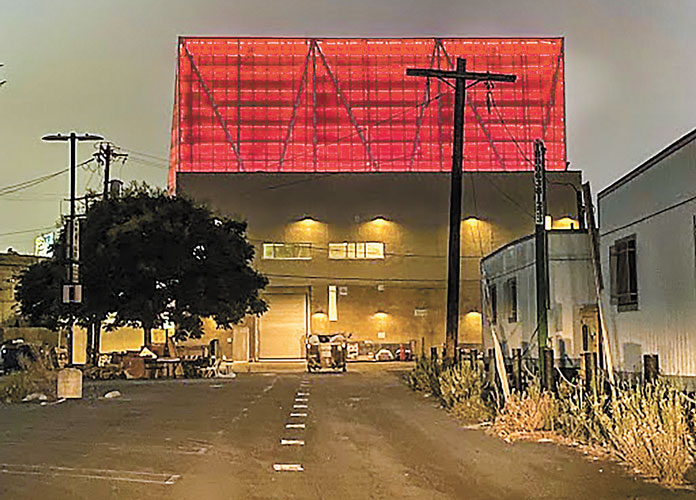
Passion
What do you love about what you do?
Asatur: I’ll go first, if you don’t mind. My answer is very simple. For a brief time, I worked in the private sector. The difference between working for the City is that I’m not designing for an individual client, family, or corporation. I’m designing for millions and millions of people. I’ve done Rec and Parks projects where I was able to take my… two-year-old daughter to the park and she enjoyed playing in the park that I took part in designing. Making a difference in people’s lives for generations, that makes a big difference for me.
Before this interview I came from a Sanitation yard, a clean water conveyance facility in North Hollywood, which I designed. The client [Sanitation] is very grateful. It’s going to be in operation for the next five decades. It makes a difference in many people’s lives. That justifies me working for the City versus maybe having my own practice.
We did a story on that conveyance project a few months ago. Congratulations!
Asatur: I appreciate it. Thank you.
We throw around the word “iconic” a lot, but, in my opinion, this facility is really going to be iconic for Leimert Park. We didn’t talk about one of the most elegant features of the facility – the marquee and the Vision Theatre Tower in front of the Theatre. It’s going to be the beacon of light, and mark the location. It’s going to attract a lot of people. I learned a lot about African-American culture while being on this project. And I believe this will give many other people an opportunity to learn about this culture, too.
Daniel: Every day, through my work at the Dept. of Cultural Affairs, I get to work with talented and creative professionals who are all serving our common mission and goals of providing essential arts and cultural programming to the residents and visitors of the City of Los Angeles. While the work is not easy, we see the rewards every day through our impact on the people that we serve at our art centers, theaters, historic sites, galleries, as well as through grantmaking, public art, and strategic marketing, development, design, and digital research.
Yvonne: I love being of service. This community has been waiting for so long. They’ve been so patient. My having the gift of serving this community in this way has been kind of like being a surrogate mother; it has been hard work, but joyful work. Everyone says I’m going to be crying when it opens, and I will. The invisible will be made visible. The baby will be born.
The Vision Theatre will serve the community and the City as a beacon; it will glow like a gemstone. It will be sheathed in light signifying a safe haven for the performing arts (dance, Theatre, music and film). Having once been a church and a theater, it is hallowed ground in this community. And to know that I have been a part of stewarding that, of being of service in this way, has been the honor and pleasure of my life.
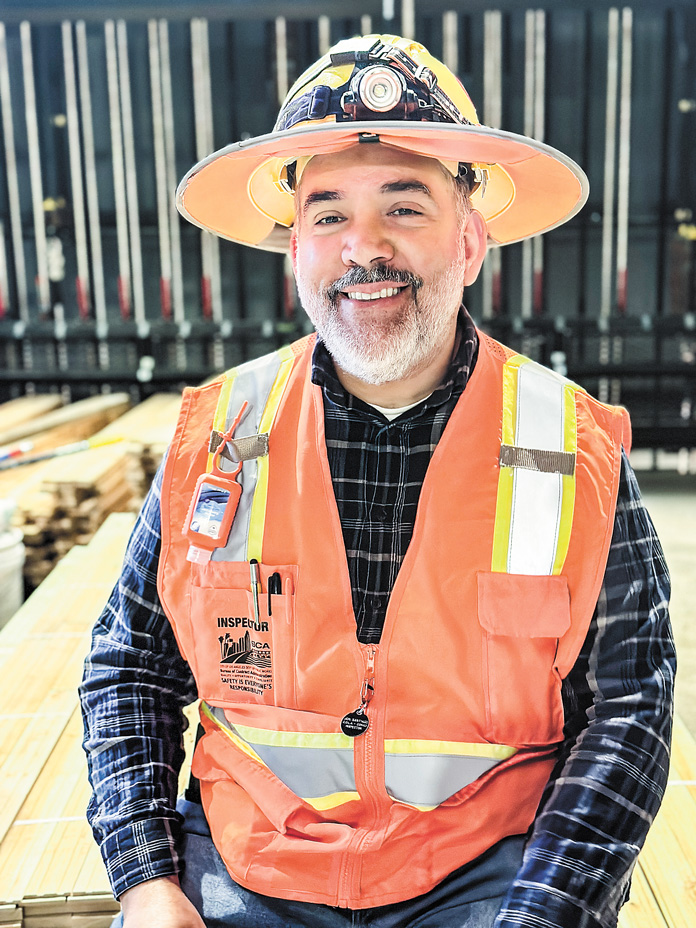
You had talked earlier about being an actress, dancer and choreographer as well as a filmmaker; all those things are enormously creative. But I can’t imagine this being any less creative.
Yvonne: Project management is extremely creative! When you have felt what it’s like to be on stage and experience the creative force moving inside you; and then to know that it’s now been redirected in this new way, and you again feel that creative force working in you through this medium – oh, my goodness, what a high! It’s an affirmation of the Spirit at work in everything we do. I am so very grateful.
Asatur, Yvonne, and Daniel, thank you so much for your time and all you do for the citizens of LA.
Daniel: Thank you for allowing us to tell the story of DCA’s Vision Theatre and give you a glimpse into its future!
Asatur: I appreciate it. Thank you.
Yvonne: Ashe! – And So It Is, Amen •
|
BEHIND THE SCENES
|


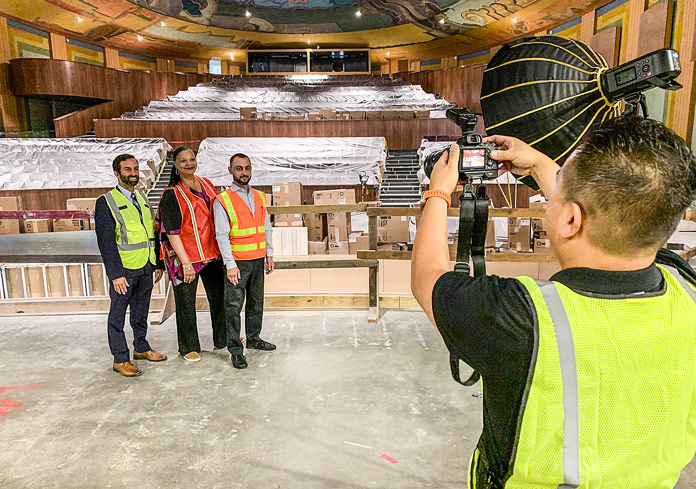 Photographer and Club COO Summy Lam photographs (from left) Daniel Tarica and Yvonne Farrow, Cultural Affairs; and Asatur Keymetlyan, Public Works/Engineering inside the Vision Theatre.
Photographer and Club COO Summy Lam photographs (from left) Daniel Tarica and Yvonne Farrow, Cultural Affairs; and Asatur Keymetlyan, Public Works/Engineering inside the Vision Theatre.
